
If you have dived in Cocos Island Costa Rica before, please share your experiences: Dive spots you would recommend, which Dive Center you used, Fishes & Diving, Visibility, Currents, etc. Please post your comments in the section below, by doing so you will help fellow divers to plan their next trip

Cocos Island is the world’s most remote diving destination with regular liveaboard service!
“The world’s most remote diving destination with regular liveaboard service.”and “The most beautiful island in the world.” are two ways to describe the remote Cocos Island of Costa Rica. The island along with a few small islands and the surrounding waters are a national park that is 340 miles (550 km) off the Pacific coast of Costa Rica.
The Cocos Island National Park is a liveboard only destination. Liveaboards depart the mainland from the port of Puntarenas for a 36 hour journey. There is no stops for diving along the way and no islands either. This is the only way to get to the park, as there is no airport or even a place to stay on the island. Twelve park rangers live on the island and no other people.
I usually use this website to book in advance my liveaboards in Costa Rica as they usually have the lowest rates I find. I like it because they have an easy booking system.

Coco Island By Rodtico21 (Own work) [CC BY-SA 3.0], via Wikimedia Commons
Cocos Island
As you approach the island you will be struck by its beauty. Jacques Cousteau said it was the most beautiful island in the world. The island is a mountain top. The base is thousands of feet below and its top stands 2,100 feet (634 meters) above sea level. If weather and sea conditions permit, liveaboard guest may be allowed to land on the island and explore.
Cocos Island is heavily covered with a jungle and the massive mountains have impressive waterfalls. If you were impressed by the waterfalls in the first Jurassic Park movie being here allows you to see them in real life as those scenes were shot on the island.
The sea around the island is what brings the divers. Surrounded by fringing reefs, the islands are home to many species of marine life and has some of the highest biomass in the world, second only from its closest neighbors Darwin and Wolf Islands which is still over 450 km away. The biomass of smaller species is the highest in the world.
The conditions here can be difficult, so it is a location for experienced divers only.
In this page you will find more detailed information about scuba diving in Cocos Island Costa Rica.
Table of contents
Best Dive Review
Scuba Divers are drawn to this Cocos Island National Park because of the diversity of the marine life and its pristine conditions. The fringing reefs around the islands are sparsely covered with coral, however, they still attract multitudes of smaller fish. While there are a few very nice coral gardens, the majority of the underwater seascape is slopes and rocky boulders.
Many of the species of the smaller fish are know to perform functions of cleaner fish, and these slopes are ideal to set up as a station. There are hundreds of locations where the pelagics come for the cleaning stations. While many Shark species can be found waiting their turn for an unoccupied cleaning station it is the Hammerheads, Silky Sharks and Manta Rays that are seen in the greatest numbers. The producers of the 1999 IMAX film Island of the Sharks need a place that guaranteed massive numbers of sharks, so they filmed here.
Most of the best dive sites are between 60 feet and 100 feet deep, roughly 18 to 30 meters.
Visibility can range from 10 meters to 30 meters and at times visibility in plankton rich waters may drop to 5 meters when a current changes.
Current changes is a concern for Scuba Divers, so most liveaboards stress these dives are for experienced divers. A diver considering a liveaboard vacation should carefully check the certification requirements for the liveaboard of their choice. While some say they accept Open Water Divers, they require them to have 25 dives and certified for deep and night diving. The dive guides are the authority to determine if a diver is qualified to dive any site. Most of the liveaboards will dive the easiest sites first to give the divers time to hone their skills before the more challenging sites.
How to dive Cocos Island Costa Rica?
The port of Puntarenas is the departure point for the liveaboards going to the Cocos Island National Park. The crew of the liveaboard will pick up the passengers at a destination hotel in San Jose, Costa Rica. Guest are expected to arrive the day before departure and be ready for an early morning pick up. It is a two hour journey to the port from San Jose. San Jose has excellent connections to other international cities.
Most of the Liveaboards are 10 day trips, this allows for 7 days of diving with three dives a day. The park authority has designated 20 dive sites, from which most liveaboards generally will dive 14 sites.
Where to stay?
I usually use this website to book in advance my hotels in Cocos Island Costa Rica as they usually have the lowest rates I find. I like it because it's free to cancel and change the dates.
Best time to dive in Cocos Island Costa Rica
The best time to go to Cocos island will vary due to divers desires. The island has two seasons, a rainy season and a dry season.
The Dry season is December – May and has the best sea conditions. Those who are not comfortable in rough weather out of sight of land for a day will find this the best time of the year to go. Most of the pelagics are still sighted in large numbers, just fewer than the rainy season.
The Rainy season from June to November can have very rough sea conditions and of course the most rain. It is, however, the peak time of the year for Hammerhead sharks, Whale sharks and Manta Rays. Many repeat visitors to the national park, swear by going in July. The sea conditions are more variable and the Hammerhead and Whale Shark are approaching their peak.
Top liveaboards in Cocos & Costa Rica according to divers reviews
Dive courses
Enriched Air Nitrox is recommended for diving the Cocos Island, and most liveaboards will offer this course. Open Water Diver training is not offered. It may be possible to do a deep diver certification or drift diver, however prior coordination will be required as many of the boats require these certifications to join the sailing.
Scuba Diving conditions
Some of the dive sites are sheltered, however, most are in open water off the coast of the island. Many of the dive sites are themselves the tops of submerged mountains and have the potential for strong currents around and over them.
Water Temperature: 75 – 86°F (24 – 30°C) some thermocline is possible during rainy season
Visibility: 30 – 100 ft (10 – 30m) an up flow current from deep water may have a little less visibility.
Depth Range: 30 – 131 feet (10 – 40m)
Snorkelling in Cocos Island Costa Rica
This destination offers little for the snorkeler.
Fishes and Coral
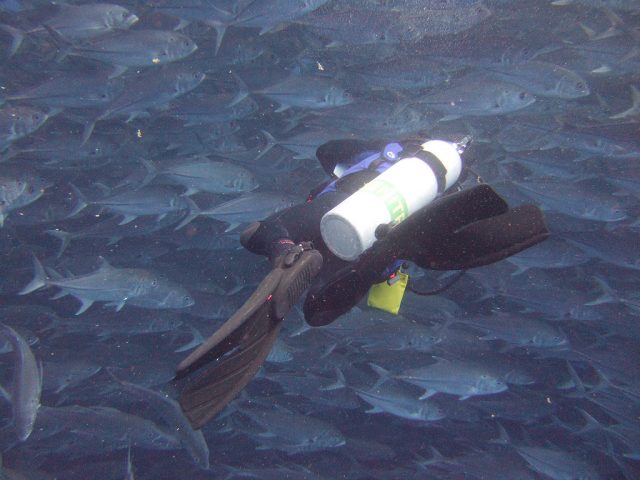
by Clifton Beard creative commons
Year round the park offers large schools of
- white tip reef sharks
- silky sharks,hammerheads
- silver tips
- dolphins
- marlin
- mantas and marbled rays
- giant moray eels
- green turtles
- sailfish
- and the occasional whale shark.
These are attracted by the large number of reef fish that make their homes among the reef and rocky slopes. At certain times of the year, the numbers increase dramatically and will also include other species such as hawksbill turtles. Whale sharks, Hammerheads and White Tip Reef Sharks are at their peak numbers between around June and July.
Diving Safety
If you are planning an upcoming dive trip or travelling to Cocos Island Costa Rica, it is a really good idea to invest in travel insurance for scuba diving, because you never know what could happen and when you might need it (because accidents do happen!). I recommend this diving insurance as they offer worldwide coverage and focus on providing scuba divers a quality insurance and medical assistance service.
The Cocos Island National Park is a destination for the experienced diver that loves marine life. The high concentration of Sharks and other large marine life is balanced by the largest biomass of reef fish in the world. Its remote location insures only serious divers are in the water. The combination of marine life and remoteness will make you feel that the dive sites are only for you and the few divers with you.
Photos Cocos Island Costa Rica
-
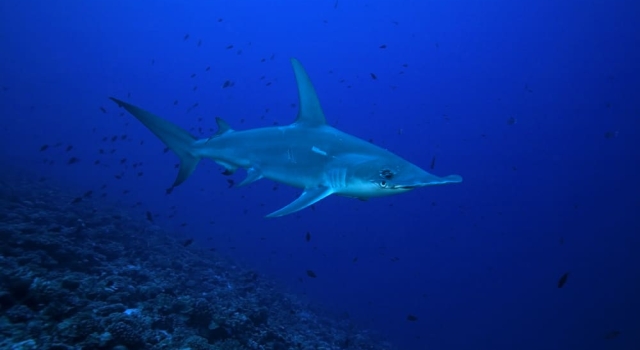 Huge Hammerhead Shark patrolling the reef in French PolynesiaPhoto by Yann Hubert
Huge Hammerhead Shark patrolling the reef in French PolynesiaPhoto by Yann Hubert -
 Blacktip Shark patrolling the crystal clear water... EPIC photo!Photo by Yann Hubert
Blacktip Shark patrolling the crystal clear water... EPIC photo!Photo by Yann Hubert -
 Flying Ray Manta in Bali!Photo by Jihye Lee
Flying Ray Manta in Bali!Photo by Jihye Lee -
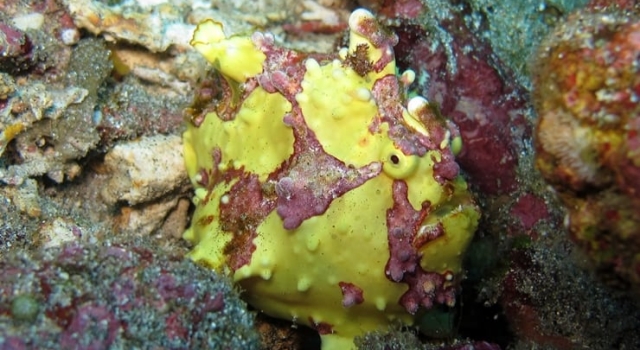 FrogfishPhoto by Jihye Lee
FrogfishPhoto by Jihye Lee -
 Manta Ray ComingPhoto by Matthieu Billaud
Manta Ray ComingPhoto by Matthieu Billaud -
 Stack Eagle RaysPhoto by Matthieu Billaud
Stack Eagle RaysPhoto by Matthieu Billaud -
 Rare Orange FrogfishPhoto by Rich Guest
Rare Orange FrogfishPhoto by Rich Guest -
 Wide Manta RayPhoto by Matthieu Billaud
Wide Manta RayPhoto by Matthieu Billaud -
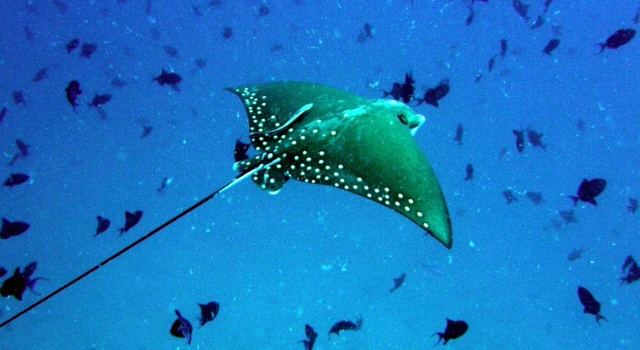 Wonderful Eagle RayPhoto by Matthieu Billaud
Wonderful Eagle RayPhoto by Matthieu Billaud -
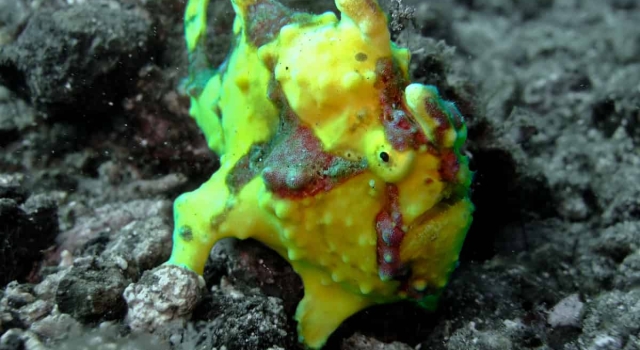 Small Yellow FrogfishPhoto by Rich Guest
Small Yellow FrogfishPhoto by Rich Guest
Travel Guide
Now that you know all about the underwater world, you might want to start planning your scuba holiday! Check out our Cocos Island Costa Rica Travel Review for information about how to get there, activities and excursions, where to stay, and more.

Diving Reviews for this region
Costa Rica
Costa Rica offers experienced divers some of the best diving in the world.
Dive spots reviews in Cocos & Costa Rica
Liveaboard Reviews in Cocos & Costa Rica
MV Okeanos Aggressor
The 33 meters liveaboard Okeanos Aggress
Cocos Island Aggressor
Journey aboard the Cocos Island Aggresso
MV Okeanos Aggressor II
MV Okeanos Aggressor II is one of the ve
 Destinations
Destinations




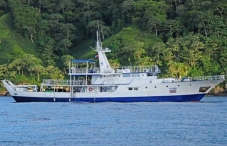





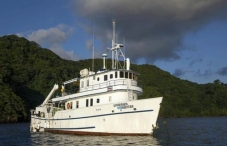
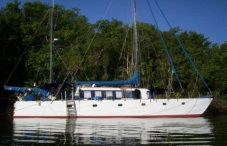

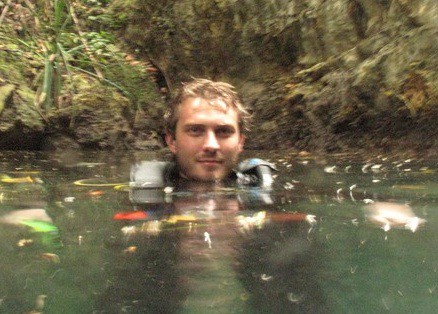




hola, soy rescue padi y me interesa realizar el divemaser y trabajar en el buceo que es lo que me apaisona vivo en uruguay pero he viajado a bucear varias veces por el caribe,brasil, mexico y egipto.
me interesa saber cuando haya una posibilidad para mi.
muchas gracias
saludos.
andrea